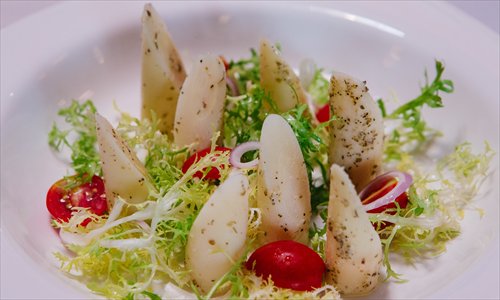
Salada de palmito, a tropical salad made with the heart of palm trees, a popular dish among Rio's health-conscious youth, on the menu at Latina in Beijing. (Photo: Li Hao/GT)
"Mmm. It's tasty," said Ricardo Lima, a Brazilian soccer player, as he dug into his food at Latina, a Brazilian restaurant in Chaoyang district, Beijing.
"It's very authentic. I like it," he said, grinning.
Surprised that he can get authentic Brazilian food in China, Lima is happy that he has found somewhere that can help assuage his cravings whenever he misses home.
Brazilian food in China does not only appeal to Brazilians; it also has a considerable following among people from other countries.
Beijinger Emily Wang wandered into the restaurant with her colleagues and instantly fell in love with the food.
"This is my very first time trying these things," said Wang as she stuck her fork into pão de queijo, a kind of cheese bread that is popular all over Brazil. "The cakes are in the shape of mini-balls, and I heard from one of the cooks that they are made with eggs, cheese, and tapioca, and are cooked as hot air enters. No wonder it is crispy on the outside and soft on the inside. It's like my taste buds have traveled to a completely different world."
Lima and Wang are not alone. Many people enjoy Brazilian food because of its unique flavors. Also, by introducing new flavors to the local community, Brazilian food plays an increasingly visible role in facilitating closer ties between China and Brazil by way of the kitchen.
A taste of Brazil
Like Lima, many Brazilians in China, and even some Chinese foodies, are grateful that they do not have to go all the way to Brazil to taste authentic Brazilian cuisine.
"The specialty is beef hump and bean stewed with pork," said Zhao Yangyang, the sous chef at Brazilian Churrascos inside V-Continent Beijing Parkview Wuzhou Hotel.
According to Zhao, the food is cooked and served in the authentic Brazilian way. "The most distinctive feature of Brazilian food is that they respect the original taste of the ingredients without adding too many kinds of spice," Zhao explained.
Taking beef hump as an example, Zhao said it is salted and left to marinate in a refrigerator overnight with diced carrots, celery, onion, pepper, myrcia, and cachaca before it is roasted for around 10 minutes, wrapped in tinfoil and then grilled in residual heat.
"Aside from myrcia, which is the only spice needed, the other ingredients are mainly vegetables, so the maximum possible original taste of the meat is preserved," he said.
Claude Cerbolles, the area manager for the Latina food chain, agreed. He said authentic Brazilian food preparation usually involves slow cooking the meat to get maximum flavor, which is the original cooking method in Brazil. He said every effort is taken to maintain authenticity, even with the meat cuts.
"The beef needs to be imported because oxen in China are smaller and we need a good-sized beef hump portion," said Pei Pei, the marketing communications manager at the V-Continent.
Commenting on why Brazilian barbecue is received relatively well in China, she said the reason is that it caters to Chinese tastes and customs. "Brazilian barbecue can satisfy people's desire for eating a large amount of meat (the meat is usually cut into big chunks) and drinking a lot of beer, so it is heaven for people who love eating meat, though it can be too much for girls," she explained.
When dining in a Brazilian restaurant, even the way the food is presented has a distinct Brazilian flair. For example, when serving beef hump, the cook would take it to the guests' table and cut it right in front of them, just like they would do it in Brazil, Pei said.
"In this way, guests can choose the part they would like to eat and taste the freshness of the meat," she said.
The authentic tableside service also allows for a better enjoyment of the meal, as the cooks have an opportunity to interact with the guests and can make recommendations for them to try.
"When I cut the meat tableside, I would tell my guests how to enjoy the meat with different sauces," said Zhao.
Bean stewed with pork, another Brazilian specialty, has also found a following among Chinese diners. Pigtail, pig's feet and ears are the main ingredients, and they are cooked with black beans for around two hours before the dish is served.
Wang said that she found the taste mouthwatering. "Maybe it's because I grew up eating luzhu (a traditional snack in Beijing with chitterlings and pig lungs in it) and chaogan'r (fried liver, another traditional Beijing snack). The taste is quite similar."



















































